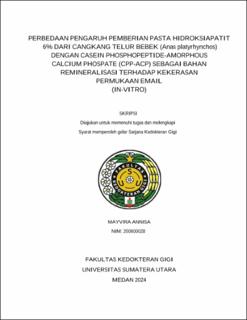| dc.contributor.advisor | Batubara, Fitri Yunita | |
| dc.contributor.author | Annisa, Mayvira | |
| dc.date.accessioned | 2024-07-04T04:18:21Z | |
| dc.date.available | 2024-07-04T04:18:21Z | |
| dc.date.issued | 2024 | |
| dc.identifier.uri | https://repositori.usu.ac.id/handle/123456789/94314 | |
| dc.description.abstract | Caries is a chronic disease resulting from the demineralization process which can reduce the hardness of enamel surface so a remineralization agent is needed, one of them is CPP-ACP. But, CPP-ACP can’t be used in individuals who are allergic to cow’s milk. Natural ingredients are more biocompatible with body tissue also can be used, such as duck eggshells which contain 94% calcium carbonate. The aim of this research was determining the difference in the effect of giving 6% duck eggshells hydroxyapatite paste with CPP-ACP as a remineralization agent on enamel surface hardness.
This laboratory experimental study used 24 maxillary first premolars. All samples were divided into 4 treatment groups. Group I was demineralized and given 6% hydroxyapatite paste from duck eggshells. Group II was demineralized and given CPP-ACP paste. Group III was demineralized and was not given remineralized agents. Group IV was not demineralized and was not given remineralization agents. Demineralization procedure with HCL solution (pH 2) for 30 minutes. The remineralization procedure is carried out for 30 minutes. All samples were soaked in artificial saliva and stored in an incubator at 37˚C. The procedure is repeated for 14 days. The enamel surface hardness was measured using the Microvickers Hardness Tester 2 times, after demineralization and remineralization.
The results of the T-paired test showed that there was an increase in enamel surface hardness after giving the remineralization agent for each group (p<0,05). From the results of the oneway ANOVA test, the four groups showed significant differences in the increase in enamel surface hardness (p=0,0001) so it was concluded that the group given 6% duck eggshells could increase the surface hardness of the enamel. The results of the Post Hoc test LSD showed that the group had the greatest influce in increasing the hardness of the enamel surface was group I 6% duck eggshell hydroxyapatite paste.
The conclusion of this study is there is an effect of giving 6% duck eggshell hydroxyapatite paste, CPP-ACP, and artificial saliva in increasing the surface hardness of tooth enamel(p=0,0001). The application of 6% hydroxyapatite paste from duck eggshells significantly increased the enamel surface hardness compared to application of CPP-ACP paste (p=0,03). | en_US |
| dc.language.iso | id | en_US |
| dc.publisher | Universitas Sumatera Utara | en_US |
| dc.subject | Remineralization | en_US |
| dc.subject | Duck Eggshells | en_US |
| dc.subject | Casein Phosphopeptide–Amorphous Calcium Phosphate (CPP-ACP) | en_US |
| dc.subject | Enamel Surface Hardness | en_US |
| dc.subject | SDGs | en_US |
| dc.title | Perbedaan Pengaruh Pemberian Pasta Hidroksiapatit 6% dari Cangkang Telur Bebek (Anas platyrhynchos) dengan Casein Phosphopeptide-Amorphous Calcium Phospate (CPP-ACP) sebagai Bahan Remineralisasi terhadap Kekerasan Permukaan Email (In-Vitro) | en_US |
| dc.title.alternative | Differences in The Effect of Giving 6% Hydroxyapatite Paste from Duck Eggshell (Anas platyrhyncos) with Casein Phosphopeptide-Amorphous Calcium Phosphate (CPP-ACP) as a Remineralization Agent on Enamel Surface Hardness (In-Vitro) | en_US |
| dc.type | Thesis | en_US |
| dc.identifier.nim | NIM200600028 | |
| dc.identifier.nidn | NIDN0026068501 | |
| dc.identifier.kodeprodi | KODEPRODI12201#Pendidikan Dokter Gigi | |
| dc.description.pages | 101 Pages | en_US |
| dc.description.type | Skripsi Sarjana | en_US |


